the blog
A place for our team to share about topics they are passionate about, in hopes of allowing you to see and understand a bit more behind the faces on these pages.

Why Talk about Suicidality?
First, a trigger warning. My next series is focusing on suicidality. If you're not ready to read them, please prioritize self-care. See you in my next series!
Suicidality is often misunderstood. Conversations about suicide reveal stigma, fear, and numerous misconceptions. Fear is natural when contemplating the potential outcomes of suicidal thoughts. Yet, this stigma, defined as "a mark of disgrace associated with specific circumstances, qualities, or individuals" by Oxford Languages, prevents people from seeking help. This is why I've chosen to address suicidality in this series. If you have suicidal thoughts, you're not alone or "crazy." Suicidal ideation is a normal response to feelings of hopelessness and helplessness, as I'll explain in my next post. While it's not the desired outcome, understanding why suicidality occurs can bring relief and self-compassion.
I use "normal" because many experience passive, unintrusive thoughts about death, the absence of life, or dying. For some, these thoughts are so subtle they go unnoticed. These thoughts and their associated emotions and physical sensations often operate beneath our awareness until they disrupt our ability to function and enjoy life, similar to anxiety or depression. The concern with persistent and intrusive thoughts, emotions, and physical sensations linked to suicide is that they can become dangerous if left untreated. In upcoming posts, I'll delve into why suicidal ideation happens, debunk myths that contribute to stigma, and explain the spectrum of suicidality. My aim is to foster a better understanding of suicidality and reduce the stigma, enabling more support for those in need.
Til next time,
Tanya Rae
Office Location: 1200 Brock Street South, Whitby, ON. L1N 4L9
© Marquis Counselling & Consulting | ALL RIGHTS RESERVED | TERMS & CONDITIONS | PRIVACY POLICY
